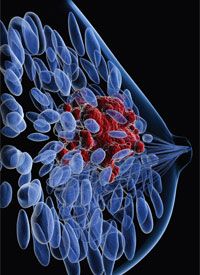Trastuzumab Biosimilar Demonstrates Equivalence in HER2+ Breast Cancer
The trastuzumab (Herceptin) biosimilar SB3 induced a rate of breast pathologic complete response similar to trastuzumab in women with HER2-positive breast cancer, according to results from a phase III study of 800 patients.
breast cancer

SB3, a trastuzumab (Herceptin) biosimilar developed by Merck and Samsung Bioepsis, induced a rate of breast pathologic complete response (bpCR) similar to trastuzumab in women with HER2-positive breast cancer, according to results from a phase III study of 800 patients.
Investigators also found that SB3 was associated with comparable safety outcomes.
From April 2014 to August 2015, patients were randomly assigned to 8 cycles of SB3 (n = 402) or trastuzumab (n = 398) concurrently with 4 cycles of docetaxel followed by 4 cycles of fluorouracil, epirubicin, and cyclophosphamide. Patients then underwent surgery, followed by 10 cycles of adjuvant SB3 or trastuzumab.
In the per-protocol population, 51.7% of patients achieved bpCR in the SB3 group compared with 42.0% in the trastuzumab group. The adjusted bpCR ratio was 1.259 (95% CI, 1.085-1.460), which was within the predefined equivalence margins. The adjusted difference was 10.70% (95% CI, 4.13-17.26), with the lower margin contained within and the upper margin outside the predefined equivalence margins. Based on the study design, SB3 would be considered equivalent for bpCR if the 95% CI of the ratio was within 0.785 to 1.546, or the 95% CI of the difference was within ±13%.
At the time of data cutoff, the median follow-up was 337 days (range, 94-489) in the SB3 arm and 338 days (range, 24-475) in the trastuzumab arm. Investigators wrote there were no relevant differences between the 2 arms in the mean values for the relative dose-intensity of both investigational products and noninvestigational products.
The treatment groups were well balanced for demographics and baseline disease characteristics, with no statistical differences between the 2 arms. The median page age was 51 years (range, 22-65). Most patients (52.8%) had T2 disease and clinically involved lymph nodes (79.5%). Estrogen receptor (ER) and progesterone receptor (PR) were negative in 40.9% of tumors. The mean left ventricular ejection fraction level at baseline was 65.24%.
In the intent-to-treat population, the bpCR rate was 49.0% in the SB3 arm and 39.7% in the trastuzumab arm. The adjusted ratio of the bpCR rate was 1.243 (95% CI, 1.070-1.444), and the adjusted difference in the bpCR rate was 9.59% (95% CI, 3.26-15.91). In the intent-to-treat population, total pathologic complete response rate was 45.8% in the SB3 arm and 35.8% in the trastuzumab arm.
The bpCR rates were higher in ER- and PR-negative patients than in ER- and/or PR-positive patients. Event-free survival and overall survival data had not yet matured at the data cutoff date.
More than 95% of patients in both groups experienced treatment-emergent adverse events (TEAEs) during the neoadjuvant period.
In the trastuzumab group, the most common (≥20%) TEAEs were neutropenia (63.7%), alopecia (63.2%), nausea (30.4%), and leukopenia (24.4%). The most common (≥20%) TEAEs in the SB3 group were neutropenia (67%), alopecia (67%), nausea (31.1%), leukopenia (27.9%), and diarrhea (20.1%).
None of the 4 deaths in the study was considered to be related to the study drug.
Outcomes were similar between the 2 arms for TEAEs of special interest. In the SB3 arm, the rate of infusion-related reaction was 8.2%, the rate of asymptomatic left ventricular systolic dysfunction was 0.9%, and rate of congestive heart failure was 0.5%. Those rates in the trastuzumab group were 10.0%, 0.7%, and 0%, respectively.
The PK population included 161 in the SB3 arm and 152 in the trastuzumab arm. Mean Ctrough profiles from cycle 3 to cycle 8 were similar between the 2 treatment groups. A total of 99.2% of patients in the SB3 group and 97.3% of patients in the trastuzumab group had Ctrough values >20 µg/mL at predose cycle 8. At cycle 8, the geometric least squares mean ratio of Ctrough was 110%, 52.535 µg/mL in the SB3 arm and 47.816 µg/mL in the trastuzumab arm. The 90% CI was 102% to 119%, which was contained within the predefined equivalence margins.
Three patients in the SB3 arm expressed antidrug antibodies (ADAs) up to cycle 9 compared with none in the trastuzumab group. One of those 3 obtained bpCR, and none presented significant TEAEs related to immunogenicity. Investigators said the overall incidence of ADAs was too low to perform a statistical analysis of the relationship between the ADA status and efficacy or safety, but there was no significant difference between patients who were ADA positive and negative.
In December 2017, the FDA approved another trastuzumab biosimilar, MYL-1401O (Ogivri; trastuzumab-dkst), for HER2-positive patients with breast cancer or metastatic gastric or gastroesophageal junction adenocarcinoma.
Pivot X, Bondarenko I, Nowecki Z, et al. Phase III, randomized, double-blind study comparing the efficacy, safety, and immunogenicity of SB3 (trastuzumab biosimilar) and reference trastuzumab in patients treated with neoadjuvant therapy for human epidermal growth factor receptor 2—positive early breast cancer [published online January 26, 2018]. J Clin Oncol. doi: 10.1200/JCO.2017.74.0126.



